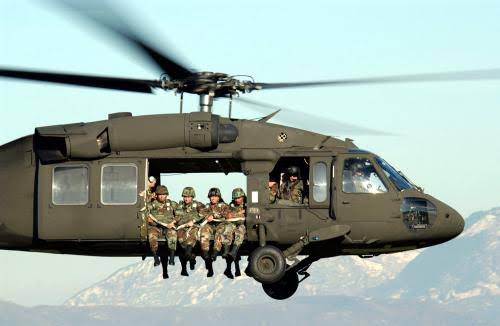Understanding the UH60: The Ultimate Military Helicopter Experience
The UH-60 Black Hawk helicopter stands for a crucial advancement in army aeronautics, combining robust engineering with complex functional abilities. As we explore the history, requirements, and technological developments of the UH-60, it ends up being noticeable that its duty in forming modern armed forces approaches is both significant and considerable.
Background of the UH-60
Emerging from the requirement for a versatile utility helicopter throughout the late 1960s, the UH-60 Black Hawk was established by Sikorsky Aircraft Company in feedback to the U.S. Army's requirement for a modern-day field of battle transportation helicopter. The design process commenced in 1972, culminating in its first trip in October 1974. The Black Hawk was engineered to change the aging UH-1 Iroquois, likewise understood as the "Huey," which had been a staple of Army aviation given that the Vietnam War.

Over the years, the Black Hawk has actually undergone various upgrades, keeping its importance in contemporary military procedures. Its success has brought about the growth of numerous variants, offering multiple branches of the U. UH60.S. army and allied forces worldwide, establishing the UH-60 as a cornerstone of armed forces aviation background
Key Attributes and Requirements
The UH-60 Black Hawk is identified by its advanced style and robust specs, which contribute to its flexibility on the field of battle. This multi-role helicopter includes a twin-engine arrangement, powered by two General Electric T700-GE-701C engines, delivering a maximum result of 1,800 shaft horse power each. This effective engine configuration enables the Black Hawk to get to a maximum rate of around 183 knots (211 miles per hour) and a service ceiling of 19,000 feet.
The airplane's composite rotor blades give phenomenal lift and ability to move, while its four-blade primary rotor system boosts stability (UH60). The Black Hawk is equipped with innovative avionics, including an electronic cockpit and night vision capabilities, guaranteeing efficient procedures in varied problems. Its cabin can fit as much as 11 troops or lug up to 8,000 pounds of freight, making it appropriate for different logistical needs
The UH-60's modular design permits simple upkeep and upgrades, ensuring long life and versatility in advancing military needs. Additionally, its sophisticated survivability attributes, such as crashworthy seats and armor, boost crew security during goals. Overall, the UH-60 Black Hawk represents a significant development in military air travel technology.
Operational Functions and Goals
Flexibility is a characteristic of the UH-60 Black Hawk, enabling it to do a vast variety of functional functions and objectives throughout numerous army environments. Mostly developed for troop transport, the Black Hawk can carry as much as 11 soldiers and is frequently utilized in air assault procedures, allowing rapid insertion and extraction of ground forces in opposed areas.

Along with troop transportation, the UH-60 is proficient at medical emptying (MEDEVAC) missions. Equipped with advanced clinical devices and workers, it can swiftly leave wounded soldiers from the combat zone, significantly enhancing survival prices in important situations. The helicopter likewise plays an essential duty in logistics sustain, providing supplies, ammunition, and tools to ahead operating bases in ascetic environments.
Additionally, the Black Hawk acts as a system for special operations objectives, including reconnaissance and direct action. Its ability to run in different terrains and its low-flying capacities make it an important possession for units performing covert procedures.

Technological Improvements
Advancement in air travel technology has actually considerably improved the capabilities of the UH-60 Black Hawk, ensuring its significance in modern armed forces operations. The helicopter is outfitted with innovative avionics systems that provide pilots with remarkable situational awareness, including multi-functional screens, improved GPS, and sophisticated terrain awareness systems. These functions make it possible for accurate navigation and goal execution, even in tough settings.
In addition, the assimilation of data systems permits secure and instantaneous information exchange in between devices, assisting in worked with operations. The UH-60's upgraded rotor systems and composite materials add to improved efficiency, offering better rate, dexterity, and minimized upkeep prices.
Additionally, developments in tool systems, such as the capability to release precision-guided munitions, improve the Black Hawk's role in combat circumstances. The helicopter's capacity to sustain medical evacuation objectives is additionally boosted by new clinical equipment and innovations, guaranteeing reliable patient treatment en route.
Last but not least, ongoing improvements in stealth modern technology and sound reduction mechanisms better strengthen the UH-60's effectiveness in covert operations, allowing it to run in aggressive areas with a decreased likelihood original site of detection. Collectively, these technical innovations highlight the Black Hawk's enduring prestige in military air travel.
Impact on Modern War
Boosted abilities of the UH-60 Black Hawk have actually profoundly influenced modern warfare strategies and strategies. Its flexibility in troop transport, medevac operations, and reconnaissance roles has actually redefined the functional landscape for army pressures. The helicopter's capacity to run in diverse settings, from metropolitan settings to tough terrains, permits greater tactical flexibility, making it possible for commanders to adjust swiftly to altering battleground problems.
The UH-60's advanced avionics and communication systems boost situational understanding, assisting in real-time knowledge sharing and coordination amongst devices. This capability is important in modern-day crooked war, where fast decision-making can figure out the end result of interactions. The helicopter's capacity for quick insertion and extraction of unique procedures forces has come to be this page a trademark of contemporary armed forces campaigns, stressing rate and accuracy.
Additionally, the Black Hawk's combination with unmanned airborne systems and various other innovative innovations symbolizes a change in the direction of multi-domain operations. As an outcome, the UH-60 not just works as a crucial asset in conventional conflicts but likewise plays an essential function in counterinsurgency and peacekeeping objectives, highlighting its enduring influence on modern armed forces doctrine and the development of war.
Final Thought
The UH-60 Black Hawk stands for a pinnacle of armed forces air travel, defined by its convenience, progressed design, and durable design. Its capabilities in troop transport, clinical discharge, and logistical assistance underscore its necessary function in contemporary armed forces operations. Continuous technological improvements and enhancements have further solidified the Black Hawk's tactical importance, allowing fast action and flexibility in diverse combat circumstances. Ultimately, the UH-60 remains an important asset, forming the landscape of contemporary war and operational efficiency.

Advancement in aeronautics technology has considerably boosted the capacities of the UH-60 Black Hawk, ensuring its importance in modern military procedures.The UH-60 Black Hawk represents a pinnacle of armed forces aviation, defined by its convenience, progressed engineering, and durable style.
Comments on “Explore the UH60's Effect on Armed force Approach and Tactical Mobility”